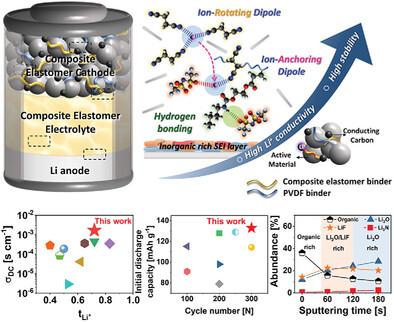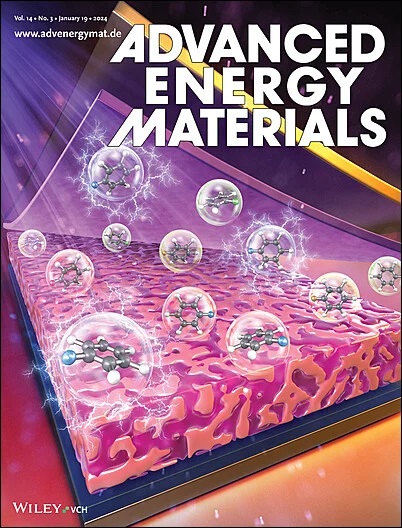Ion-Anchoring Dipole-Integrated Composite Elastomer Electrolyte and Cathode for High-Performance Lithium Metal Batteries via Multiple-Bridge Engineering
IF 24.4
1区 材料科学
Q1 CHEMISTRY, PHYSICAL
引用次数: 0
Abstract
Solid-state electrolytes (SSEs) hold significant potential for advancing lithium metal batteries (LMBs) by enhancing safety through the replacement of liquid electrolytes. However, challenges such as low ionic conductivity, limited electrochemical stability, and poor electrolyte/electrode interface compatibility hinder the development of high-energy-density LMBs. Herein, a strategy for designing SSEs is proposed using multiple-bridge engineered composite elastomer electrolytes (CEEs) that incorporate ion-rotating dipole interactions, ion-anchoring dipole interactions, and hydrogen bonding, along with a CEE-based composite elastomer cathode (CEC). This design combines a volume-adaptive elastomer matrix, a high-Li+ conducting deep eutectic electrolyte, and robust nanowires. The resultant CEE exhibits high ionic conductivity (1.7 × 10−3 S cm−1), a lithium transference number of 0.72, and a wide electrochemical stability window (up to 4.9 V) at 298 K. The engineered uniform Li+ flux also promotes stable Li plating/stripping for over 900 h at 0.1 mA cm−2. Furthermore, the LFP-based CEC|CEE|Li full cells deliver a reversible capacity of 133 mAh g−1 with 95% retention after 300 cycles in coin cells, and 129 mAh g−1 with 96% retention after 250 cycles in pouch cells at 1 C. This strategy presents a promising approach for designing solid-state polymer electrolytes to extend the lifespan of high-energy-density LMBs.

求助全文
约1分钟内获得全文
求助全文
来源期刊

Advanced Energy Materials
CHEMISTRY, PHYSICAL-ENERGY & FUELS
CiteScore
41.90
自引率
4.00%
发文量
889
审稿时长
1.4 months
期刊介绍:
Established in 2011, Advanced Energy Materials is an international, interdisciplinary, English-language journal that focuses on materials used in energy harvesting, conversion, and storage. It is regarded as a top-quality journal alongside Advanced Materials, Advanced Functional Materials, and Small.
With a 2022 Impact Factor of 27.8, Advanced Energy Materials is considered a prime source for the best energy-related research. The journal covers a wide range of topics in energy-related research, including organic and inorganic photovoltaics, batteries and supercapacitors, fuel cells, hydrogen generation and storage, thermoelectrics, water splitting and photocatalysis, solar fuels and thermosolar power, magnetocalorics, and piezoelectronics.
The readership of Advanced Energy Materials includes materials scientists, chemists, physicists, and engineers in both academia and industry. The journal is indexed in various databases and collections, such as Advanced Technologies & Aerospace Database, FIZ Karlsruhe, INSPEC (IET), Science Citation Index Expanded, Technology Collection, and Web of Science, among others.
 求助内容:
求助内容: 应助结果提醒方式:
应助结果提醒方式:


